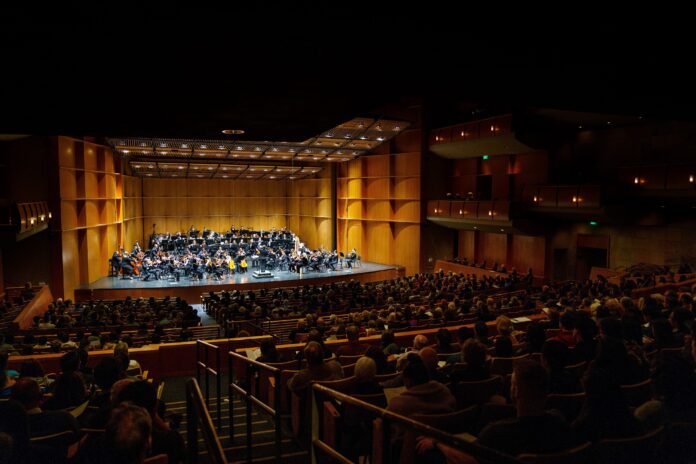An innovative new piece from a French-Argentine composer was performed on April 21
By JACOB ANDERSON — arts@theaggie.org
On April 21, the UC Davis Symphony Orchestra put on a performance called “Effects and Dances,” comprising two contemporary pieces, one of which has never before been performed in the U.S. The premiere of Oscar Strasnoy’s “Kuleshov” — a piano concerto here starring a California-born doctorate student at Cornell, Ryan McCullough, on the principal instrument — is the nexus of the evening. Strasnoy himself is here, and the French-Argentine composer takes the stage alongside McCullough and UC Davis Symphony Orchestra conductor Christian Baldini before the music starts.
Strasnoy is in an eye-catching pinstriped suit and explaining the cinematic influence behind the structure of “Kuleshov.” Named after the Soviet filmmaker Lev Kuleshov, the piece is centered around an aural application of Kuleshov’s editing ideas. It comprises a series of musical “images” that rotate around one central theme. It’s meant to provoke the listener — is that theme really the same as the one before it, or is it shifting alongside the context in which it’s invoked? The degree to which context and repetition affect the perception of one musical idea is Strasnoy’s fascination, apparently. Talking with Baldini, he says his “main source for this work was silent film accompaniment music from the 1920s. Surely those musics were influenced by certain features of those composers, so my references are surely second hand.”
Strasnoy’s striking ideas are part of what he’s termed a rejection of “artistic homogeneity,” in which many young composers become stuck imitating their teachers fruitlessly.
“I would recommend [students] avoid as much as possible emulating the contemporary musical currents taught in universities, which turn almost all students into epigones,” Strasnoy said. “Being an artist means being free to do whatever you want with whatever ideas, material or media you want. If you don’t achieve that degree of independence, you will not be an artist, you will be a craftsman, which is not bad in itself but was probably not your initial plan.”
His desire for originality comes through in the concerto, which places the stark, challenging main theme between more expansive sections that give it time in which to breathe. McCullough is the most striking part of the ensemble, and he’s almost shaking in his seat as he hits the most violent chords in the piece toward its end.
The second piece in the show is Jimmy López Bellido’s “Fiesta!” which combines elements of Latin-American, Afro-Peruvian and modern pop music, an effort which the show’s program declares has the intention of “establish[ing] a connection with younger generations.” Three of the piece’s four movements are named after modern trends in electronic music — ”Trance 1,” “Trance 2” and “Techno” — the lattermost term he connects to Hindu music, where “melodies unfold through a series of melismas against a pedal note and over a span of several minutes.”
This second piece is more constant and conventional than Strasnoy’s, but the integration of modern musical concepts still separates it from any kind of formalism. The later movements reach a hypnotic pitch, through which heavy percussion echoes.
The orchestra takes their bows alongside Baldini, Strasnoy and McCullough at the show’s end, and the audience is left to consider the ways in which these two composers have satisfied their desires to push music in unconventional directions.
Written by: Jacob Anderson — arts@theaggie.org




